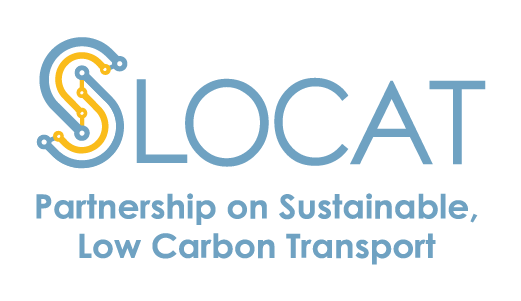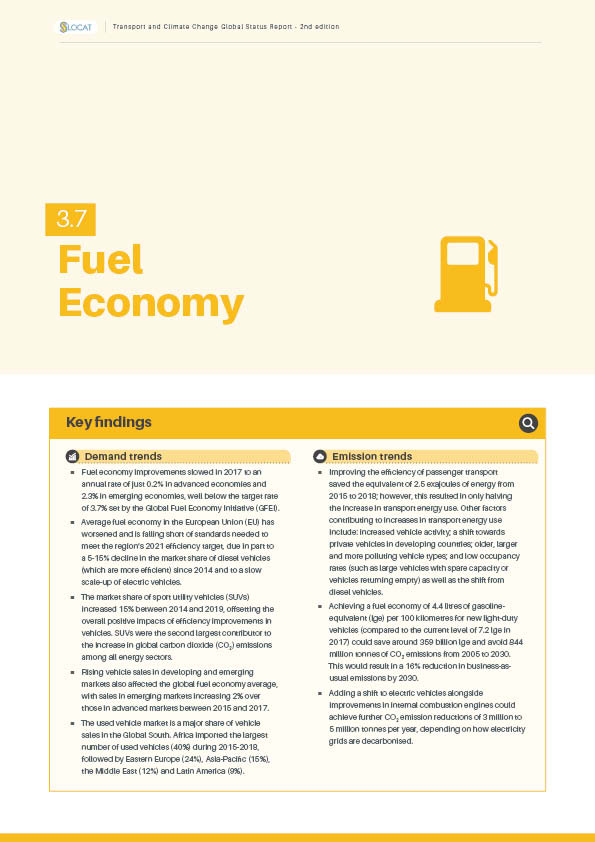Fuel Economy
Road transport is a major air polluter, contributing significant emissions of fine particulate matter and black carbon. Overall, transport is responsible for 25% of human-caused black carbon emissions, of which three-quarters are produced by diesel-powered heavy-duty vehicles.
The average fuel economy of passenger vehicles in 2017 was 7.2 litres of gasoline-equivalent (lge) per 100 kilometres. Between 2018 and 2019, overall fuel consumption increased in Europe but declined in China, the Republic of Korea and the US. Improving the efficiency and fuel economy of all vehicles (particularly internal combustion engine vehicles) can result in a projected savings of 5 million tonnes of CO2-equivalent emissions annually by 2050, compared with current policies. Such actions continue to be vital for decarbonising transport.
To maximise emission reductions, a switch to vehicle technologies with zero tailpipe emissions is also needed. This could save another 5 million tonnes of CO2-equivalent emissions annually by 2050, especially if combined with bans on internal combustion engine vehicles by 2030. These steps will be especially important in the wake of the COVID-19 pandemic, when many national and local trends point towards a shift to greater passenger car use.
The Global Fuel Economy Initiative (GFEI) is a partnership of six leading transport and energy organisations. It serves as a global reference point on the improvement of fuel economy standards and has set a target to double the average fuel economy of light-duty vehicles by 2030, reducing CO2 emissions 90% by 2050 (compared to 2005). Meeting this target requires a 3.7% annual improvement in fuel economy, which countries are not yet close to meeting, as they have only achieved a 1.5% annual improvement. The GFEI has also set reduction targets for two- and three- wheeled vehicles, heavy-duty vehicles and buses.
Key Findings
-
Demand trends
Fuel economy improvements slowed in 2017 to an annual rate of just 0.2% in advanced economies and 2.3% in emerging economies, well below the target rate of 3.7% set by the Global Fuel Economy Initiative (GFEI).
Figure 1.
Light-duty vehicle fuel economy by country, 2005-2017
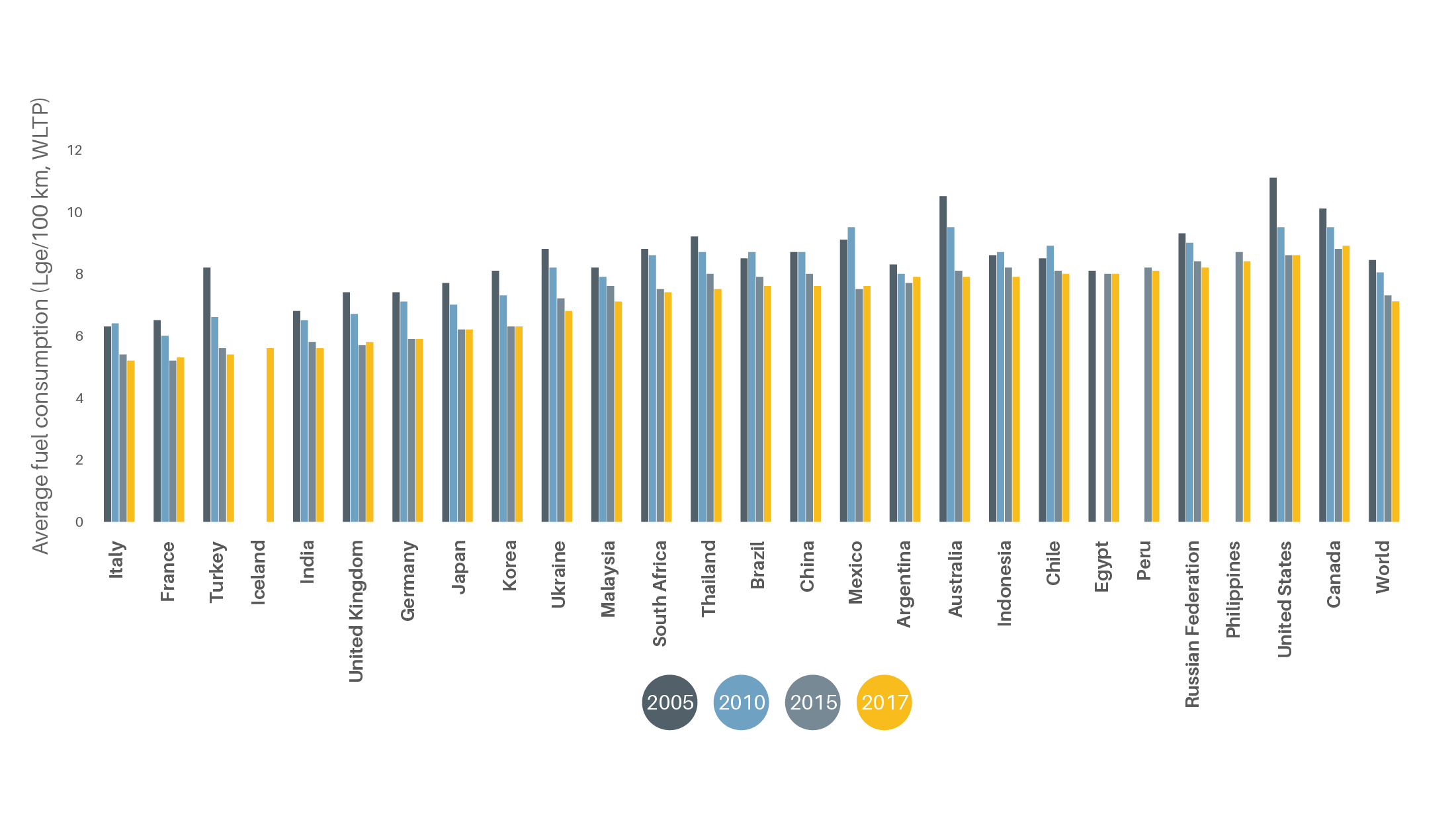
Average fuel economy in the European Union (EU) has worsened and is falling short of standards needed to meet the region’s 2021 efficiency target, due in part to a 5-15% decline in the market share of diesel vehicles (which are more efficient) since 2014 and to a slow scale-up of electric vehicles.
The market share of sport utility vehicles (SUVs) increased 15% between 2014 and 2019, offsetting the overall positive impacts of efficiency improvements in vehicles. SUVs were the second largest contributor to the increase in global carbon dioxide (CO2) emissions among all energy sectors.
Rising vehicle sales in developing and emerging markets also affected the global fuel economy average, with sales in emerging markets increasing 2% over those in advanced markets between 2015 and 2017.
The used vehicle market is a major share of vehicle sales in the developing world. Africa imported the largest number of used vehicles (40%) during 2015-2018, followed by Eastern Europe (24%), Asia-Pacific (15%), the Middle East (12%) and Latin America (9%).
-
Emission trends
Improving the efficiency of passenger transport saved the equivalent of 2.5 exajoules of energy from 2015 to 2018; however, this resulted in only halving the increase in transport energy use. Other factors contributing to increases in transport energy use include: increased vehicle activity; a shift towards private vehicles in developing countries; older, larger and more polluting vehicle types; and low occupancy rates (such as large vehicles with spare capacity or vehicles returning empty) as well as the shift from diesel vehicles.
Achieving a fuel economy of 4.4 litres of gasoline-equivalent (lge) per 100 kilometres for new light-duty vehicles (compared to the current level of 7.2 lge in 2017) could save around 359 billion lge and avoid 844 million tonnes of CO2 emissions from 2005 to 2030. This would result in a 16% reduction in business-as-usual emissions by 2030.
Figure 2.
Updated GFEI fuel economy targets (reductions from 2005 baseline)
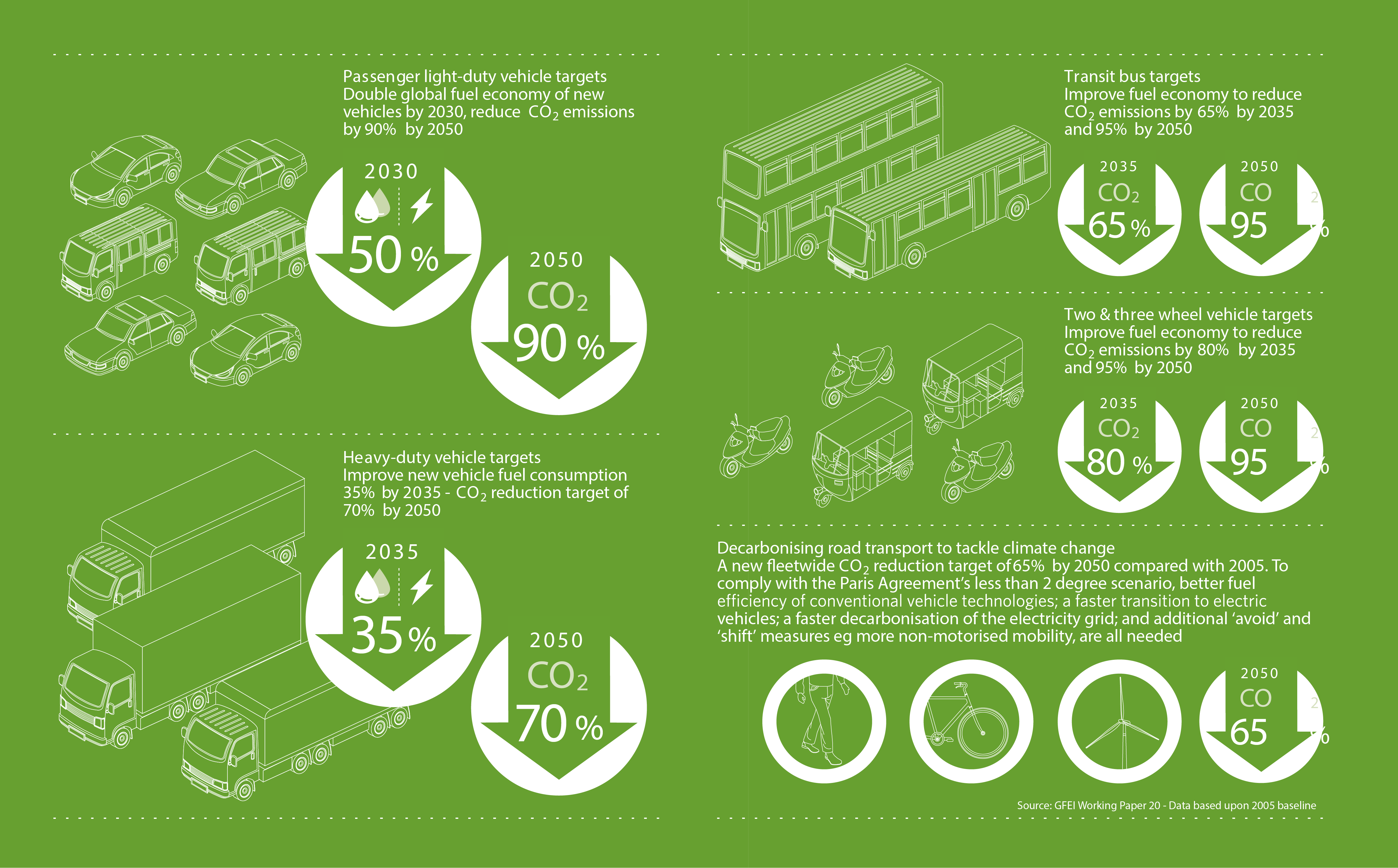
Adding a shift to electric vehicles alongside improvements in internal combustion engines could achieve further CO2 emission reductions of 3 million to 5 million tonnes per year, depending on how electricity grids are decarbonised.
-
Policy Measures
As of 2020, 54 countries had established fuel economy policies, such as labelling schemes that help consumers compare vehicle choices and understand tax implications over the lifetime of the vehicle.
Figure 3.
Implementation of vehicle fuel economy labelling programmes in selected countries, 1978-2020
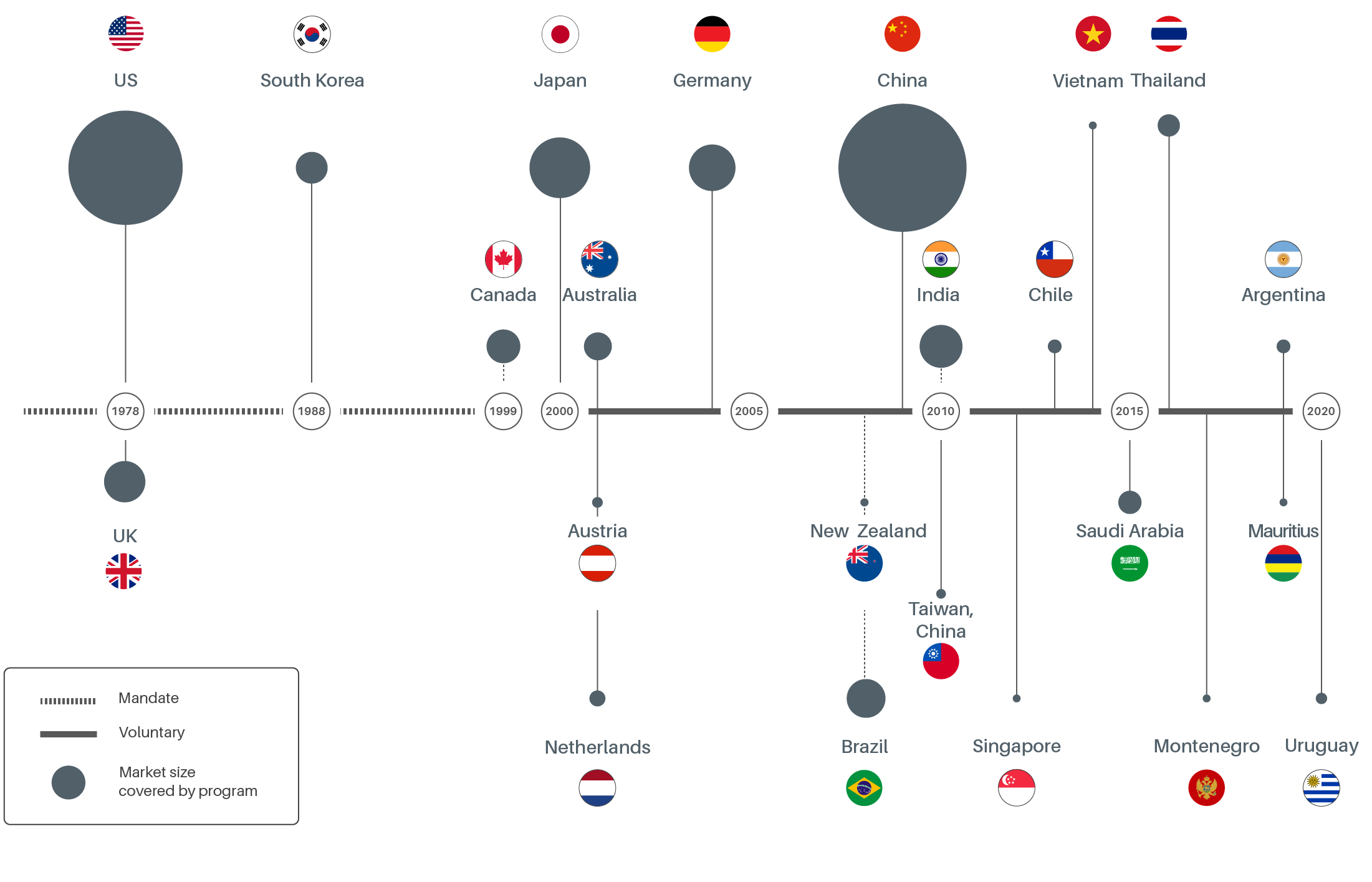
By 2019, 89 developing countries across Asia, Africa, Latin America and Eastern Europe had made national and regional commitments to improve fuel economy.
Complementary “Avoid” and “Shift” strategies must be adopted to achieve the additional 2-5 million tonnes of annual CO2 emission reductions from road transport needed to meet Paris Agreement goals.
Figure 4.
Emission reductions through vehicle efficiency-related measures by 2050
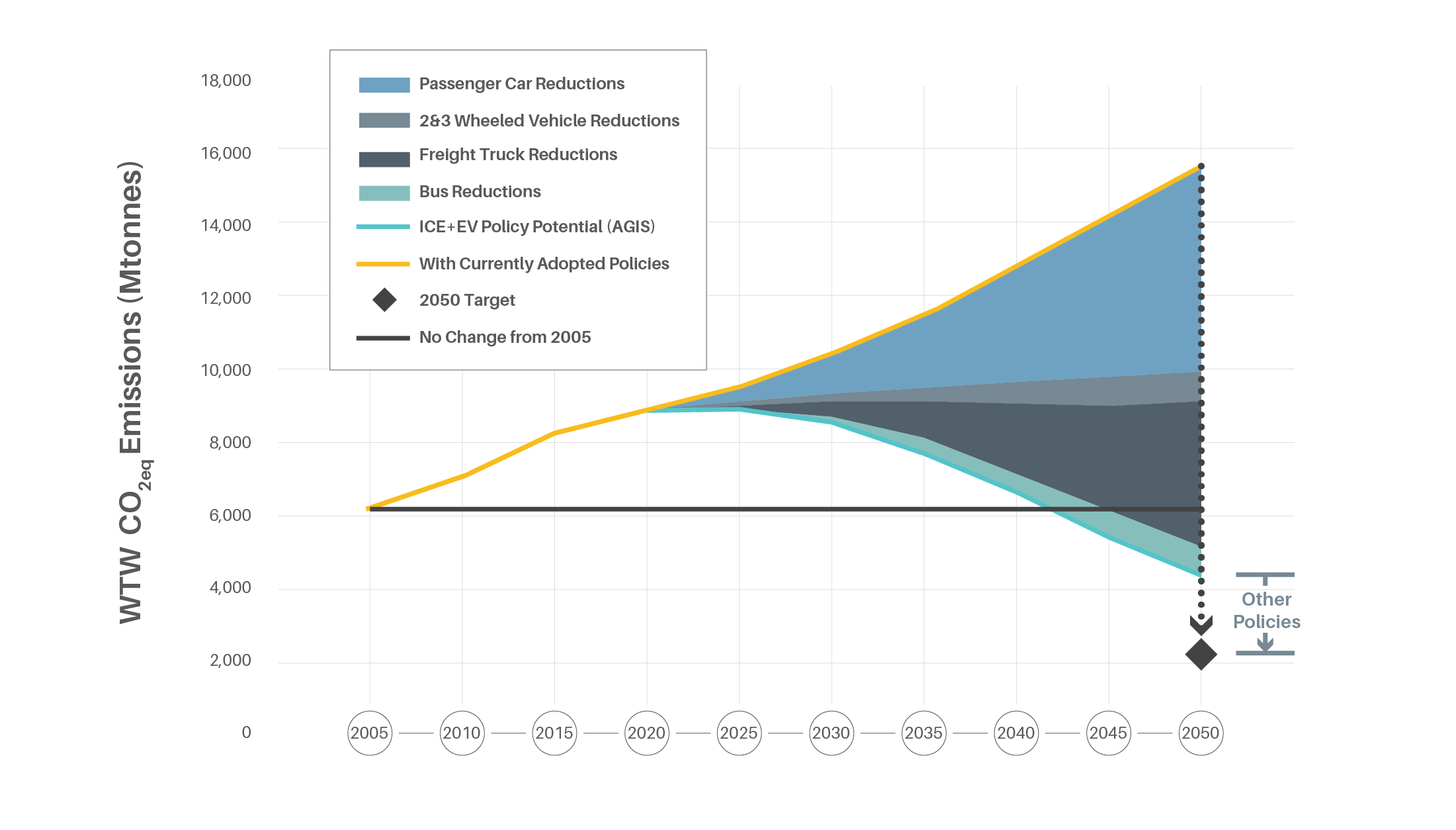
A number of emerging economies and regions are setting roadmaps and targets to accelerate the transition to more efficient vehicles through fuel economy improvements.
CO2 emissions and fuel consumption of passenger cars in selected countries, 2000-2018 and future targets
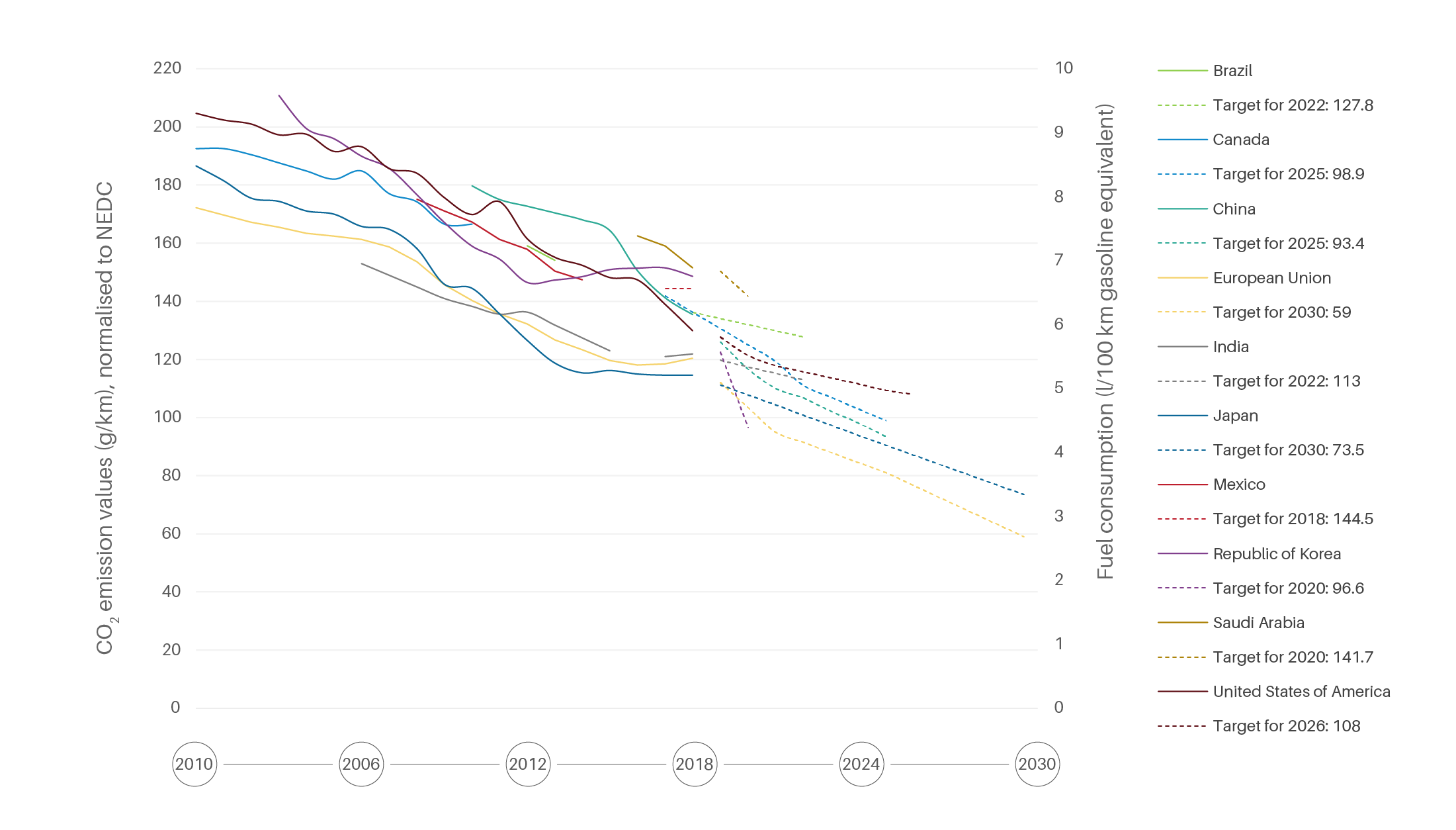
In 2019 and 2020, no new national fuel economy mandates were adopted for trucks and other heavy-duty vehicles. Canada, China, the EU (including the United Kingdom, UK), India, Japan and the United States (US) remain the only entities with fuel economy standards for heavy-duty vehicles.
Fuel economy policy is increasingly being integrated into wider frameworks for promoting the transition to electric vehicles.
-
Impacts of the COVID-19 pandemic
In the wake of the pandemic, there has been pressure on regulators to ease future vehicle fuel economy and emission standards, which are critical to addressing the climate crisis and the health impacts of air pollution.
Following the pandemic, many national and local trends point towards a short-term exodus from public transport and a shift to greater passenger car use, highlighting the need to maintain robust fuel economy standards.
Key indicators
2017*
2019*
% change
Key indicators
(# of countries)
2017*
2019*
% change
Key indicators
(# of countries)
2017*
2019*
% change
Key indicators
(# of countries)
2017*
2019*
% change
Key indicators
(# of countries)
2017*
2019*
% change
Key indicators
(# of countries)
2017*
2019*
% change
Key indicators
2017*
2019*
% change
Key indicators
2017*
2019*
% change
(*) Data are for the indicated year unless noted otherwise.
